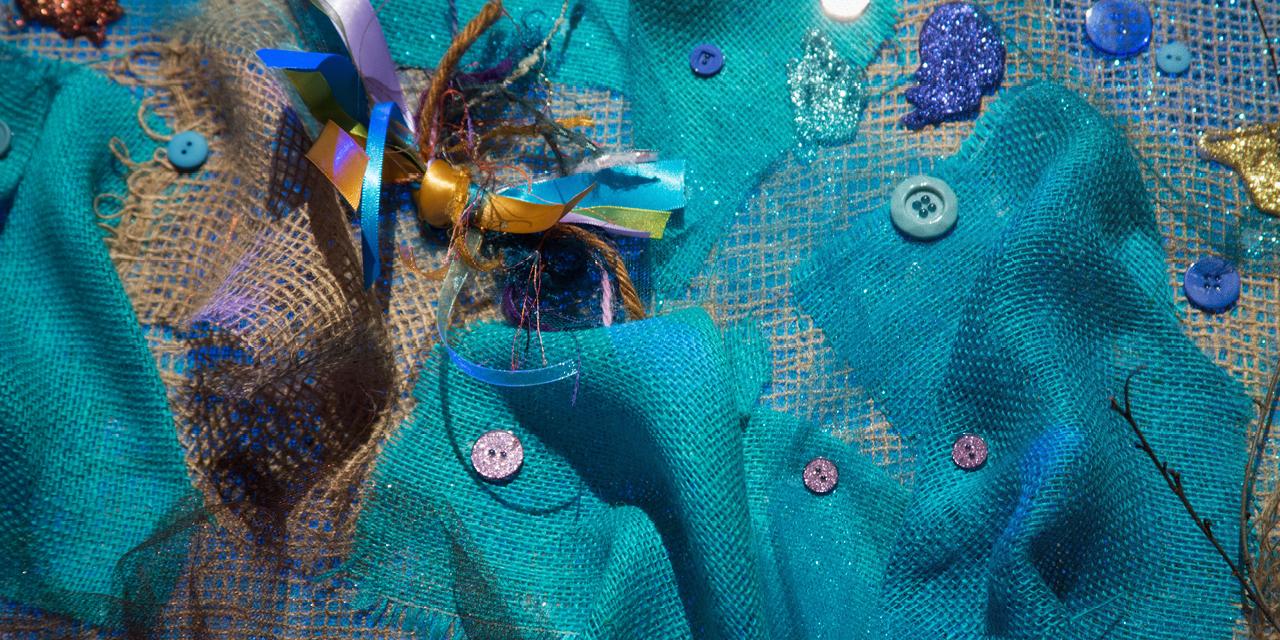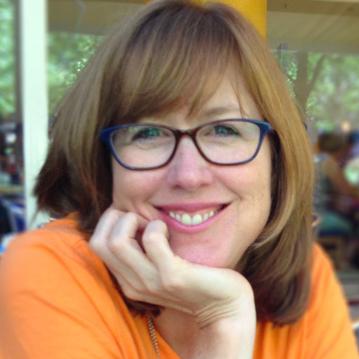Ellen Gadberry is an educator, artist, and librarian—always, as she says, "looking for joyful, creative ways to connect great people and great ideas." She teaches art at a jail, works with nonprofits for children, and volunteers many hours at North Decatur Presbyterian Church in Decatur, Georgia (metro Atlanta). In this edited conversation, Gadberry describes how a Vital Worship Grant helped her congregation "become a communal visual choir."
What was your congregation's Vital Worship Grant about?
North Decatur Presbyterian Church has a rich history of intentional integration of worship and all of life, especially in our commitment to peace, justice, and welcoming everyone. But we have room to grow in increasing our biblical literacy, finding God in the visual, and making our lives a continuing act of worship. So our Vital Worship Grant focused on expressing scripture through art to increase biblical literacy and awareness of God's beauty. We did it by tracing God's covenant through sermons, adult education, weekly artmaking groups, and more.
What did your artmaking groups do?
Even before the grant, I'd been facilitating two groups. The Liturgical Arts Group met at church on first and third Thursday evenings. Their job was to support, enhance, and extend elements of worship in our community through the visual arts. The Craftivists met at church on second and fourth Thursday evenings. They focused on arts-based activism, often by joining larger campaigns with other groups and congregations. Either way, we see it as God working through our hands to do good in this world. There was a big overlap in membership between the two groups. When the pandemic arrived, we switched those groups to Zoom.
What kind of liturgical art did you make during the grant year?
The name of our grant was “God's Creative Story,” and our sermons in that grant year explored the “Big Ideas of the Bible," including creation, covenant, liberation, and more. The Liturgical Arts Group created a ginormous string art piece, inspired by installation artist Gabriel Dawes, to evoke the concept of covenant and to recognize Atlanta’s October celebration of Pride. We strung yards of sewing thread onto dozens of cup hooks to create a beautiful rainbow effect. It was installed high up between two chancel alcoves, where natural light played across the striking and delicate form. People were sad to see it go when Advent came.
We also made papier-mâché banners for Advent. Our artists created two-foot-square collages on the November theme of liberation using found and original poetry, documents, and images. The collages were painted in a translucent purple glaze, and the eight resulting panels were hung on the walls of the sanctuary. As Advent progressed, the banners glowed with more light week by week as another ring of battery-powered bulbs was added to each piece. During Lent and Easter, we had planned to flood the sanctuary with paper flowers made by folding old church bulletins. We called them "Eastertide blooms." But then the pandemic arrived and shut everything down.
Since you couldn't gather in the worship space, how did you reconfigure your liturgical arts plans?
We used the Eastertide blooms to connect people in several ways. When the church began filming services ahead of time so people could watch on Sundays in their homes, the videographer often included Eastertide blooms in the frame. We knew people were at home feeling scared and isolated, so our Thursday night groups helped form a delivery team to do porch or window visits with every church household. For Mother's Day we delivered live rosemary plants (for remembrance) with Eastertide blooms nestled inside. For other visits we delivered bookmarks, rosemary shortbread cookies made from rosemary grown on our church property, and of course Eastertide blooms.
We asked people to send us photos of the Eastertide blooms tucked into their own greenery and began using those to create a photo montage shared at the end of virtual worship. When we returned to outdoor worship for Easter 2021, we hot-glued blooms to the numbered cards that showed where each person or family should sit in socially-distanced squares. We also decorated the outdoor stage with the blooms. They became our visual theme of connection.
And what do the Craftivists work on?
As part of our peace and justice commitment, each month our church reads aloud the names of Georgia residents who died by gun violence. During the fall of our grant year, our co-pastor Beth Waltemath suggested we get involved with the national Soul Box Project, for which people hand-fold origami paper boxes to remember those injured or killed by guns. After the pandemic began, even more NDPC members joined us in making more than 1,200 Soul Boxes.
The Craftivists also collaborate with Knit Wits, an NDPC prayer shawl ministry that began in 2007, on a climate change project. It was part of the national Tempestry Project, which "blends fiber art with temperature data to create a bridge between global climate and our own personal experiences through knitted or crocheted temperature tapestries." The Craftivists knitted panels of 365 rows using different yarn colors to show the daily high temperature in Atlanta. They also shared personal stories about their featured year of temperature data.
How have your pastors used visual arts in worship?
When we were recording worship services early in the pandemic, Erin Reed Cooper, our very gifted director of children, youth, and families, made Godly Play videos. You wouldn't see her at all, just the characters. I also remember a prayer filmed in her back yard. She painted letters onto her deck with water while praying. David Lewicki, our other co-pastor, often chooses a single image on the screens for most of the service. This slowly but surely is opening our congregation to visual awareness and more acceptance of visuals in worship.
What did your grant year teach you about helping worshipers connect with God through visual art?
I've realized how important it is to explain what you are doing and why. Our Advent banner project was very meaningful for the artists who participated. But if you asked most people what they remembered, it was "those purple banners." Not many realized there was a liberation theme in the layers of the work. Since then I've recognized that to do process art for liturgical use, it needs to be a huge communication project. It would have been good to publish or briefly speak on the Advent banner during the worship services.
Can you say more about process art and inviting people to participate in it?
Like Lilly the mouse says in Kevin Henkes' children's book Chester's Way, "I like everything!" I like painting, drawing, crafting, sewing, building, anything artsy. But not everyone is like that. We've learned that many people decline invitations to join the Liturgical Arts Group because they don't see themselves as artists or creative people. While we have no illusion that everyone can or should be a practicing visual artist, we do feel strongly that all people’s experience of worship can be deepened by three things: a greater understanding of visual art in and of the church, a sense of their own unique creative nature as children of the Creator, and an invitation to simply give a new thing a try.
That's why we do process art, which emphasizes the process of making art more than the final product. You don't need fine art techniques to make a visual impact. Liturgical artist Nancy Chinn suggests focusing liturgical art on color, scale, symbol, and use of light.
What kind of art does your congregation view as low risk or most accessible?
Before the pandemic lockdown, we hosted Karla Kincannon, who wrote Creativity and Divine Surprise: Finding the Place of Your Resurrection. After a Saturday collage workshop, she led the entire congregation in the process of crafting a small clay pinch pot right from their pews on Sunday. Art made in the worship hour has become a more frequent component of our services. Smartphone photography works well, too. People responded when we asked them to photograph the paper Eastertide blooms in their home greenery, and they continued to contribute photos from the church wildflower garden and elsewhere. We still use members' photos in a montage at the end of many of our Sunday worship events.
Your grant poster says that your congregation has become a communal visual choir.
Yes, the poster quotes me as saying "We have become a communal 'visual choir,' using our gifts of making, painting, building, and crafting as acts of worship to the glory of God." Though I often use the term, it hasn't yet become widespread. But thinking of ourselves as a visual choir works in our setting, because "choir" is a very strong identity at our church, as it is in many Presbyterian congregations. Also, when we sing "All God's children got a place in the choir," we're saying that we're all invited to sing for the glory of God and the good of worship communities. In the same way, we're all invited to contribute visuals. And thanks to our grant, we have seen members discover that their creative work is its own form of worship.
Learn More
Read about North Decatur Presbyterian Church's Vital Worship Grant. Connect with Ellen Gadberry on her Contemplative Crafting Instagram. She sometimes uses resources from A Sanctified Art, a team of artists that creates multimedia worship resources.
Explore the Tempestry Project, Soul Box Project, and ways to mentor others through smartphone photography. Remember that being forced to move to virtual worship can unleash creativity.


